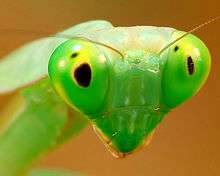Pseudopupil

Close up image of a mantis' face (Rhombodera basalis) showing the black pseudopupil in its compound eyes.
The eye of a mantis shrimp has three regions, each with its own pseudopupil.
In the compound eye of invertebrates such as insects and crustaceans, the pseudopupil appears as a dark spot which moves across the eye as the animal is rotated.[1] This occurs because the ommatidia that one observes "head-on" (along their optical axes) absorb the incident light, while those to one side reflect it.[2] The pseudopupil therefore reveals which ommatidia are aligned with the axis along which the observer is viewing.[2]
References
- ↑ M. F. Land, G. Gibson, J. Horwood & J. Zeil (1999). "Fundamental differences in the optical structure of the eyes of nocturnal and diurnal mosquitoes" (PDF). Journal of Comparative Physiology A. 185 (1): 91–103. doi:10.1007/s003590050369.
- 1 2 Jochen Zeil & Maha M. Al-Mutairi (1996). "Variations in the optical properties of the compound eyes of Uca lactea annulipes" (PDF). The Journal of Experimental Biology. 199 (7): 1569–1577. PMID 9319471.
| Wikimedia Commons has media related to Pseudopupils. |
This article is issued from Wikipedia - version of the 6/5/2016. The text is available under the Creative Commons Attribution/Share Alike but additional terms may apply for the media files.
.jpg)